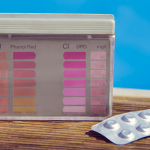CPO® Certification Basics – Chlorine and Carbon Dioxide Gas Feeders
In aquatic facility operations, chlorine and carbon dioxide gas feed systems are used to make a safer, more sanity swimming pool. Chlorine gas is used to disinfect while carbon dioxide lowers the pH balance of the water. Both gasses are held in pressure vessels in a liquid state. In both gas feeding systems, pressure cylinders are attached to a feed device through a yoke mechanism. There is an adjustable control device used to properly feed the correct amount of gas into an injection device that places the gas into a circulation line. By learning more about how these systems work, you will have an easier time getting your CPO® certification.
Chlorine Gas Feeders
When taking the test for your CPO® Certification, you will likely need to answer questions on chlorine gas. Used to disinfect a pool or spa, chlorine has a green color and is heavier than air, causing it to collect in lower areas. It has a strong, distinctive odor that can be detected at concentrations as low as .2 parts per million (mg/L). Maintaining the correct chlorine levels in a pool is extremely important, as heavy exposure can cause chest pain, vomiting, toxic pneumonitis, pulmonary edema, and even death. Even at lower concentrations, chlorine can irritate the eyes, lungs and upper respiratory tract. Chlorine gas feeding systems should be installed with a forced-air ventilation system capable of a complete air exchange in one minute or less in order to prevent dangerous exposure.
The area where chlorine is stored should be designated with a visible sign that is in accordance with local, state, and federal laws. Access to this area should also be restricted to authorized personnel only. Chlorine is an effective sanitizer but has several regulatory restrictions, leading to it to be mainly used in larger pools and those maintained by specialized, licensed service companies. The greatest risk occurs when a large cylinder of chlorine ruptures or leaks. Immediate evacuation and remediation of a facility are required in such a situation. (Gas chlorine is prohibited in many states so please check your state code for regulations.)
Chlorine Gas Cylinders
Chlorine gas is shipped and stored in pressurized vessels. Due to the dangers associated with a leak or rupture, the utmost care should be taken while handling them. They should always be stored upright and all cylinders, regardless of the contained amount of chlorine should be individually secured to a wall or another fixed device. All cylinder valves not in use should be protected by the proper caps. Each cylinder should be marked with their arrival date and the oldest cylinders should be changed first. This is called the “First in, first out principle.”
Carbon Dioxide Gas Feeders
In recent years, carbon dioxide gas has become a popular alternative method for pH control in swimming pools and spas. When dissolved in water, carbon dioxide produces carbonic acid. Once inserted into the circulation line, the carbonic acid reduces the pH levels in the water. Keep in mind that when carbon dioxide is used, it can increase the total alkalinity of the water, so it should be monitored closely.
Carbon dioxide is delivered to a facility in high-pressure tanks that can be as large as 750 pounds, depending on the amount of water being treated. To control the release of carbon dioxide, those with a CPO® certification will use a release regulator. The regulator is connected to an automated feeding system and injection of the gas is accomplished with a venturi or booster pump. Injection of carbon dioxide should occur downstream from all circulation system components.
Expert CPO® Certification
Keep in mind that this is only one small aspect of maintaining a safe and sanitary swimming facility. To learn more, go to the experts at Pool Operation Management. Pool Operation Management’s CPO® certification training courses train you how to properly operate a swimming pool or spa facility. Our two-day courses offer a wealth of information and training in everything from pool chemicals to energy conservation to risk and liability. For the very best in pool operation, contact us today.








